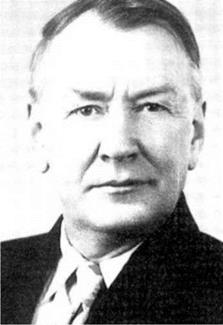CHANGING WAYS TO GO
The 3rd August 1964 resolution On work involving the study of the moon and outer space should have settled the Soviet moon plan. On the surface of things, it not only set the key decisions (lunar landing, around the moon) but the method all in one go. By contrast, the Americans had decided how to go to the moon in two stages, taking the decision in May 1961 and settling on the method, LOR, in autumn 1962.
In reality, the decision of August 1964 settled much less than it appeared. Many of the parties involved continued to fight for the decisions of August 1964 to be remade. Korolev would not accept the allocation of the around-the-moon project to Chelomei and spent much of 1965 trying to win it back to his own design bureau, with some success. For his part, Chelomei began to present the UR-700 as an alternative to the rocket designated for the moon landing, Korolev’s N-1.
|
Mikhail Tikhonravov at retirement |
Whereas the Americans had debated between Earth orbit rendezvous, lunar orbit rendezvous and direct ascent, the debate in Russia was over which rocket to use: Korolev’s N-l; Chelomei’s UR-700; or Mikhail Yangel’s R-56. Despite the government decision of August 1964, these were still in contention.
Russia’s three ways to go
Korolev design bureau (OKB-1) N-l
Chelomei design bureau (OKB-52) UR-700
Yangel design bureau (OKB-586) R-56
Korolev’s N-l
Korolev had originally planned the N-l as a rocket which would send large spaceships unmanned, then manned, on a flyby of Mars. The concept of the N-l dated to the period 1956-7 and was refined over the next number of years by Mikhail Tikhonravov, Gleb Yuri Maksimov and Konstantin Feoktistov. Whereas the R-7 could lift four tonnes into Earth orbit and was a huge advance in its day, the N-l was designed as a great leap forward to put 50 tonnes into orbit. Early designs assumed that the N-l would be used for the assembly of a manned Mars expedition in Earth orbit. This would be for a Mars flyby, rather than a landing, much like Korolev’s early designs for the moon. The 50 tonnes were gradually revised upward to 75 tonnes. Several such Mars proposals were developed in OKB-1 over 1959-67, based first around the assembly of 75-tonne interplanetary spaceships in Earth orbit [6].
N-1 was now adapted for a manned flight to the moon, though designers kept, in their bottom drawer, plans to redevelop the N-1 for a Mars mission, the N-1M. Korolev completed his design for the lunar N-1 on 25th December 1964.
The N-1 concept was reshaped around lunar orbit rendezvous, the same technique as that used by the Americans, although there were some differences in the precise detail. In the early stages, a double N-1 launch was considered necessary, with Earth orbit rendezvous preceding the flight to the moon, but this was seen as too complex, not essential and was eventually dropped. The tall N-1 was similar in dimensions to the American Saturn V, being almost exactly the same height. Unlike the Saturn V, the N-1 used conventional fuels (liquid oxygen and kerosene), which required a large number of engines of modest thrust, 30 altogether. The performance of the N-1 was inferior, able to send only two men to the moon and put only one on its surface.











